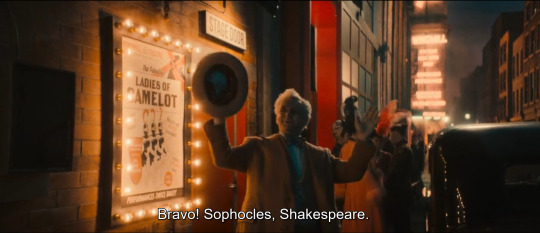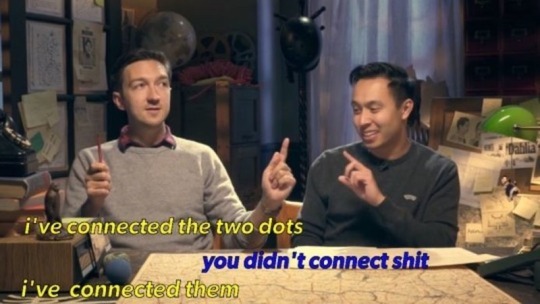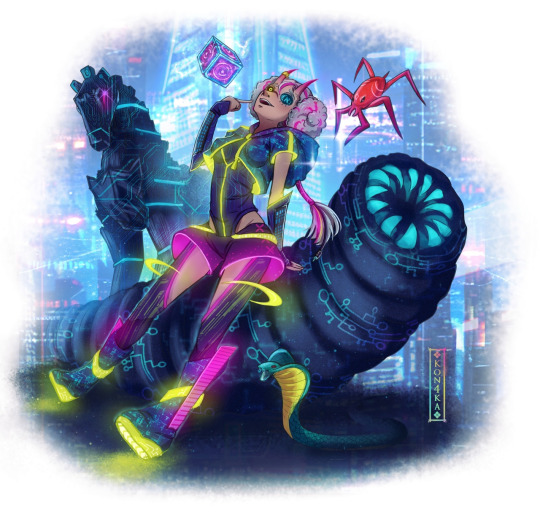#like python is so intuitive
Explore tagged Tumblr posts
Note
lmao @ the java comment from someone who has to code basically 100% java at work :’) (i mean at least java is very ubiquitous so you can often find people who had the same problem before you lmao)
my brother in christ idk how u do it! granted im not a cs major so it's not like ive even attempted to use java before, it just Looks Scary
#like python is so intuitive#and then java. u have to write all of this bs just to make a print statement jfc#or whatever the term is called in java#nameless being
4 notes
·
View notes
Text
Random silly reincarnation idea where Shen Qingqiu never thought of the mushroom and actually died trying to save Luo Binghe.
And then Luo Binghe tried his best to open the crypt but that never happened so once he gave up he went ballistic and ended up destroying half of the mortal realm, also the demon realm bc he doesn’t discriminate. Obviously he killed everyone besides his disciple siblings who were in the city that day. However he did end up destroying huan hua palace because if they didn’t kill whoever harmed what was his in the first place he would end up killing himself.
So hundred years later Shen Yuan gets reincarnated as a rich master of the Shen household [ let’s pretend they are his fathers immediate family descendants in which he SQQ never found out about ]. They have a huge agriculture and livestock empire and thus he’s a little farm boy. He doesn’t at all dabble into cultivation besides talismans and what not. He’s humble and helps out with his family’s inner farm [ personal animals ] and sometimes the commercial when management is running low. He loves goats but what he really loves are the beasts of the demon realm, which often roam after the merge of the two realms.
All Thanks to Luo Binghe. He was absolutely amazing, Shen yuan probably read all the books about him. Aswell as heard the plays, songs, and even folklore. He obsessed over his Heaven forsaken love with his old teacher. He didn’t understand why he loved him in the first place [ he’s rich, give him a break ] because his master made mistakes left and right. But nonetheless he loved it. The homos were cute in his opinion.
But anyways he had a knack for the beasts, he indulged in many books about them and had a very good intuition. He may not have a golden core but he definitely has a golden finger when it comes to knowledge on beasts.
So for at least 50 miles he’s known as the beast expert. Shen Yuan has been picked many times over next to a cultivator. Plus he’s free. These beasts can either: be tamed, fall in love with him, be scared of him, or run away. It depended but most of the demons loved him.
push comes to shove when he gets someone begging him to take care a black-moon Rhinoceros python that appeared at the border of a city. He is ecstatic to finally see one of them much to his elder brothers anguishes.
He travelled to the area and helped clear out the people. He knew a lot of information about this beast in particular because Luo Binghe had ridden one when he destroyed Huan Hua palace. Even if he wasn’t a cultivator there were other ways to calm it.
Calm he Did because he had it laying down with the python in its mouth begging for more pets within an hour.
Before he could indulge it with more something came tumbling out of the forest and killed it. There was only one sword who could kill a big beast in one swift movement and that was Xin mo. If it had been any other situation, Shen Yuan would have been fangirling over Luo Binghe blessing him with his presence. But it wasn’t, and the little[ huge ] boi he wanted to take home was dead.
So he started ranting and ranting to no ends. Luo Binghe only had a bewildered expression. No one had treated him like this. Always respectful, or fearful, or both. The last person to get this snarky with him, he had been searching for the last 100 years.
��� Shizun. I found you. “ Luo Binghe said with a smile.
then straight up kidnaps Shen Yuan. He was dragged kicking and screaming. Obviously he didn’t want to meet his hero.
So now Shen Yuan was confused because Luo Binghe keeps calling him shizun? But he just shares his family name?? Why did he think he was his dead teacher????
And plus.
He killed his fucking Black moon Rhinoceros-Python. He has an absolute vendetta against this man. So he went around his harem [ yes he has a harem, it’s mostly to distract himself from the pain of losing his shizun and yes it still has hundreds of women ] and chatted with them, making friends, and gossiping. Since he was stuck here he decided to get back at the demon emperor. So he convinced a lot of the wives to leave. He used the fact that most haven’t even seen the man for a long time.
This leaves Luo Binghe outraged because !! He needs love!!! People!!! To love him!!! But his shizun is making that difficult. Was it because he vowed to find him after he reincarnated? He didn’t know
Cue shinanigens where Shen yuan makes Luo Binghes herum smaller and smaller and having those who stayed like him very much and prefer his readings more. Luo Binghe doesn’t know what to do with him because he acted so much like the man he yearns. And he’s jealous.
He is frustrated and turned on at the same time. Luo Binghe sees that this Shen yuan loves beasts so he deliberately leads them into his harem so he can watch from afar his gushes.
Luo Binghe still gets the cold shoulder whenever they are together. He really doesn’t say why, but he’s very petty and will refuse to talk to him until he gets a black-moon Rhinoceros-python pet. Yah that’s it. But Luo Binghe doesn’t know that. He really doesn’t. He just wants his shizun back
Idk an ending yet LMAO
This is a basic outline of the concept of my fanfic!! Starting writing later but def gonna be a good idea. I love Shen yuan getting blood off him and shamelessly saying he was beginning to know the creatures here in the sect. With Luo Binghe in the background freaking out [ he’s still going to bring more creatures, Shen Yuan looks way too cute with them ].
#fanfic#fanfic ideas#shen yuan#shen qingqiu#svsss#luo binghe#Luo Binghe: please stop ignoring me :[#Shen yuan: no :]#Luo Binghe in the hall: guys please help#Shang Qinghua who’s married to mobei: act pathetic that’s how I pulled a king#Shen yuan is probably not going to get his memories as SQQ but when he was in his original life#mxtx svsss#mxtx
50 notes
·
View notes
Text
Once and Future Royalty
Just, stay with me on this one. I know its going to look crazy at the start, but trust me, I know where I'm going.

It all started with the 537AD scene in Wessex in the opening montage of "Hard Times," S1E3. Yeah, the one where Aziraphale is supposed to be a knight of the Round Table and Crowley is role-playing the Black Knight, and they are both so super-squeaky shiny clean - not a speck of dirt or mud on them. wtf! It looks out of place, unrealistic, and was bugging the crap out of me, like a stone in your shoe. It just didn't fit. I mean, why put a myth, a legend, into that sequence? Oh, OK, yeah, the preceding stories from the Bible, like the Garden of Eden and the Flood, aren't "myths" as well, you say? Hmm. In the context of the Good Omens AU, being a biblical based story, they belong there far more than the legend of King Arthur.
King Arthur, who supposedly united Britain under his rule during the late 5th century and early 6th century, was shown to have the divine right to rule by wielding the mighty sword Excalibur. Some stories tell of Arthur pulling Excalibur from a stone. Some tell of him receiving Excalibur from the Lady of the Lake. Either way, it was bestowed upon him by divine grace. Despite his triumph in battle, he left no heirs, as his queen, the fair Guinevere, was barren. She had a long-running love affair with the greatest knight of the court, Sir Lancelot, but despite this being an open secret in court Arthur would not put her aside. The knights of the Round Table in the court of Camelot were near-paragons of Christian virtue, and there are many tales of their search for the Holy Grail, the cup from the Last Supper of Jesus Christ.
In the end, mortally wounded in battle, Arthur was taken away for healing, and never seen again. It was said he would return when Britain was at it most direst hour to save the day once more. A "messianic" return.
The Once and Future King.
Now, I'm no Arthurian novice; I drank up all of T. H. White as a teenager, read the Dark is Rising multiple times, Marion Zimmer Bradley's interpretation and what ever else I could lay my hands on for a good couple of decades. And there is LOTS of King Arthur stuff around. You are not left wanting for anything new to read or consume. And I'll bet there are a fair few of you also out there who know a quite bit about the legend as well. Oh, and I can't tell you how many times I have watched Monty Python and the Holy Grail. I still walk around quoting it day-to-day, like the good little Gen-Xer I am, having grown up on that stuff. So I really should have listened to my intuition when bits of Monty Python kept popping up in my brain in response to other parts of GO I was thinking about. (Staaay, I said, stay with me here....)

I kept chewing away furiously on the Wessex problem, growling in feral frustration at it, but also kept reading and sorting out some other ideas and metas at the same time. Eventually I found the key in a tiny little post, about a small detail in the 1941 Blitz episode S2E4, of all places. I wanted to slap myself with how much was staring me in the face so obviously once the door opened. And the damn beauty of it is, that I already written about some it, out of context, without knowing the why.
OK. Where to start this journey...hmmm, back to Monty Python, because, guess what - the Wessex scene is actually riffing off one the more famous skits out the the Holy Grail. The scene is a masterpiece of political satire, from start to finish, but the relevant part here is this sequence:

In case you missed the salient points: Arthur claims he is king by divine providence, because he was given Excalibur by the Lady of the Lake. Dennis the peasant protests this waterlogged method of determination, mentioning ponds, watery tarts and a moistened... well, I hope you get the idea about where this is going.
Meanwhile, in 537AD, Wessex, as the mist swirls around them:

"It is a bit damp," complains a shiny silver Aziraphale.
Yes, Excalibur would be a bit damp after it emerged from the Lake. (vidavalor! Get your mind out of the gutter! I'm trying to have a serious discussion here! Please! And I wasn't even going to go anywhere near what the sword in the stone is really meant to be referring to...it's not even relevant to the discussion at hand, I swear! Well, there is going to be sexual relations mentioned but - oh, never mind...)

Right. Where were we. Lets leave those super-clean elite pretendy knights to swim off through the swirling mist back to their dry homes to write and file reports to head office, along with Patsy and the hired Igors, and Dennis can keep playing in his lovely muddy filth after he finishes protesting being repressed by the divinely-deluded Arthur. I've got a bit more to say about what Aziraphale and Crowley might represent here later but you need some more context first, so lets move on. I just needed to show you the first bit so you can see the Arthurian theme stretches across both S1 and S2, and will likely appear in S3 as well. More about that towards the end.
Ah, before I forget...another ref from the Holy Grail we need to cover:

This GIF, unfortunately, doesn't have the full exchange between the peasants, which is this:
P1: "Who's that then?" P2: "I don't know. Must be a king." P1: "How can you tell?" P2: "Because he doesn't have any shit on him."
Ah. Er. OH!
Have you made the connection?
Who have I been emphasizing as being unusually clean in their Arthurian setting? That's right, Aziraphale and Crowley.
What's this implying? That they are royalty. Celestial royalty. Maybe not kings, but how about princes? You know how we've been discussing whether Crowley was a once at least an Archangel, and there is even a hint that he was a fallen prince of Heaven given during the replay of Gabriel's trial? (Not the prince, but a prince - a seraphim) And that Aziraphale may have once been Raphael, and may be again in the future? Once and future royalty. To me it adds weight to the past discussion, and helps to explain the assumed authority expressed in these two scenes here: On the left, Aziraphale takes control inside the book shop as the angels and demons argue who is going to punish Gabriel and Beelzebub (finally found it after several months!) and on the right, Crowley is shouting at the assembling demons in the street that they are "out of order."


Onward, Patsy. (I hope you're still with me.)
1941, the Blitz part 2, minisode.
We've found Excalibur! On to Camelot!












[Edit note: I've added a few GIFs and screen shots into the sequence of parallels above because I was thinking over a few things since I posted and felt this actually sat better. To try and explain, as they don't exactly match as I would like, in the Holy Grail movie, King Arthur and the knights he has gathered rock up at the foot of Camelot and gaze up in awe at it. "Camelot!" Arthur declares to the party. "Camelot!" Galahad echoes in excitement. And a third "Camelot!" comes from Lancelot. What do we get in GO? Aziraphale leaps out of the Bentley (Crowley's black horse) and declares "The theater! Sophocles! Shakespeare!" I swear, if you put the two side by side, they would match. It's not just a reminder of how much time Aziraphale has seen pass by, or that we are seeing a tragedy play out. But damn it, I could so just see Aziraphale attending a Sophocles performance in Athens back in the day...]
Camelot was King Arthur's castle and home of his court. In S2 of GO the Windmill Theater is established as our court of Camelot where our 1941 Blitz-era Arthurian drama is to play out, involving Furfur and the zombies.

Yes, poor old Furfur. Two's company, three's a crowd, as they say. Now we know we're in Camelot, we need to be reminded of the central tragedy of the Arthurian story, that ultimately led to the golden kingdom's fall. Lady Guinevere, Arthur's queen, famously loved Sir Lancelot, and the two were passionate lovers. It was essentially a love-triangle at the top, with Arthur being jilted, but he wouldn't/couldn't discard his queen. Where do we see this playing out in 1941?
Furfur, pleased with himself for catching an angel and a demon in the act of consorting together (with the help of the zombies,) barges into the backstage dressing room, and confronts the lovers with their crime. But who is playing who in the Arthurian love triangle? I would say Furfur is clearly caught in the role of Arthur here. Consider the following exchange:
FURFUR: Hmm, well, well, well… What have we here? AZIRAPHALE: Sorry, have we met? FURFUR: Oh, no, you never had the pleasure, but… we have, haven't we? CROWLEY: Have we? FURFUR: What do you mean "have we?" You know we have. We were in the same legion. Just before the Fall. Doing dubious battle on the plains of Heaven. Remember? CROWLEY: I remember going into battle, I don't remember being there with you. Sorry. FURFUR: I was right next to you. We did loads together. You use to jump on me back, little monkey in the waistcoat. Anyway, whether you do or whether you don't, it doesn't matter. I'm here to inform you, as a representative of the Higher Powers of Hell, that you, Crowley, are in breach of the Infernal Code. Consulting and collaborating with an angel, Fell the Marvelous, aka… [opens book] Azirapalala. Azirapapap. Aziphapalala. AZIRAPHALE: [annoyed] Aziraphale


Furfur claims a past intimate relationship with Crowley, which Crowley spurns offhandedly. Crowley is playing Guinevere here, jilting Furfur/Arthur, which leaves the demon-smiting Aziraphale standing in for the handsome hero Lancelot (with his French connections, no less), and doesn't he make us weak at the knees when he drops his voice an octave in dominating disgust. (Is it suddenly getting hot in here...? Phew!)
Interestingly, looking back in S1 at 537AD Wessex, though, I would say that Crowley was Lancelot as the Black Knight, a role that Lancelot sometimes played in the legends, and Aziraphale would then be the fair maiden Guinevere. It certainly plays into Crowley's long term role of playing the knight who comes to the rescue of Aziraphale's princess in distress. Excalibur was no where in sight, perhaps still beneath the waters of the lake. Nor Arthur. Perhaps it was still too early in the story then...
I had originally suggested in my very first post that Furfur was given a stag as his demon avatar because he was wearing horns for being cuckolded by Crowley. But I wasn't quite thinking about it in context with the Arthurian legend! The stag is also often associated with royalty, plus while wandering around the medieval bestiary website that someone linked to, it interestingly notes that the enemy of the snake is the stag and the stork (Shax's avatar.) Ah ha!

So how can we extrapolate this knowledge into a possible appearance of the Arthurian theme in S3?
Will we see the love triangle of Arthur/Guinevere/Lancelot come back into play and cause more chaos? I'm wondering if it might have something to do with the Fall.
Or will our lovers bring down a divinely-appointed ruler via their committed behind-the-back defiance of expected propriety?
Will Excalibur appear from beneath the waters, perhaps in another form, to declare a new king?
Could it even be a combination Jesus/Arthur, King of the World, returned? And they turn out to be a very naughty boy, disappearing into the night clubs of Times Square, New York, and that's how they lose him? (Social media viral sensation, anyone?)
I wouldn't be half-surprised if Greasy Johnson's name turns out to be Arthur, actually.
And no, I haven't forgotten that Adam's dad was named Arthur as well.
Bring on S3!
**Bonus**
If you've made it this far and you're thinking:

Let me leave you with this last connection.
In the back stage change room, remember Furfur delivers these lines:
FURFUR: What do you mean "have we?" You know we have. We were in the same legion. Just before the Fall. Doing dubious battle on the plains of Heaven. Remember?
On the first level, he is referring the Great War in the Good Omens AU.
On the second level, Furfur is paraphrasing Milton's Paradise Lost.
On a third level, I can (and will in a future meta) connect this back to the training initiative paintball fight at Tadfield Manor in S1.
And even deeper on a fourth level, if you do know the Holy Grail movie well, you'll remember there is an odd little subplot in it, that infers that the whole King Arthur and his knights thing is merely a full-on violent cosplay that is murderously rampaging across the countryside in the present day with the police in hot pursuit. It's a strange juxtaposition between reality and dream, and you aren't quite sure what it is real or not. The ending is bizarrely and abruptly surreal as the two story lines collide in the heat of battle, as the police turn up and arrest the combatants. A bit like this:

#good omens#good omens 2#good omens meta#good omens analysis#aziraphale#crowley#king arthur#king of the who?#the return of king arthur#excalibur#the lady of the lake#watery tarts#monty python#monty python and the holy grail#run away#camelot#arthurian legend#ladies of camelot#guinevere#lancelot#the once and future king#once and future royalty#good omens 1941#furfur#shax#dubious battle on the plains of heaven#tadfield manor
184 notes
·
View notes
Text
What do you mean by “I could see the graph?”
I mean the above statement quite literally, and strongly believe it’s a quirk many neurodivergent individuals share.
The phenomenon is best described using an analogy to the social “intuition” neurotypical people feel when meeting someone, that 6th-sense that says “this person is good/bad/going through something.” It’s a type of intuition I will never understand, yet I find the idea of it beautiful.
My original model for the graph was built around motivation to model “language,” specifically any phrases (in the highest level of abstraction, genuinely anything you want a “phrase” to be) organized on the relation of “meaning.” Specifically, we say a phrase has “meaning” if we can describe that phrase in terms of another distinct phrase. Otherwise, we say the phrase is “meaningless,” which is somewhat of a phrase itself…
Now, it’s probably quite obvious why I keep this initial motivation hushed; I sound crazy, especially given the deviation from many syntactic models of language used for years. I have no intention to continue with that motivation. However, the abstraction I’d developed made sense to me, and eventually I realized that the best way to model such a relationship was with a rooted graph.
This is where the “intuition” part comes in, like an animation in my mind, I could build the thing up, remove edges, alter the recursive step, anything; it was my personal playground of abstraction.
I worked for weeks to truly understand and describe the structure I’d thought up. I ran to friends and advisors attempting to draw it and saying
“please tell me if I’m crazy so I can direct attention to my work.”
However, even with how admittedly scattered my initial explanation was at first, they didn’t discourage me; it was terrifying. I refused to believe that I’d truly thought of a novel graph purely in my head. But I fell in my core that this could be constructed.
And then, I wrote an algorithm in my Python, which I’ve now brought into more formal mathematical language, and it looked exactly how I’d imagined.
I have a million different questions about the basic graph theoretic properties of this object, captivated by the structure alone, although finding a “use” for this graph could be nice as well I suppose…
In summary, I did “see” the graph, my brain tends towards mathematical patterns way many tend toward social intuition. I find extreme abstraction quite comforting, and truly believe I’m not unique in this way.
I love math because it finally gives me language to explain my mind, but I was also lucky to have the right mentors. Many neurodivergent people believe they’ll fail at math because they are introduced to the field through pure computation, which feels unnatural to us.
I dream of a world where someone can develop an early course in mathematics for neurodivergent teens, so we can grow up loving the unique nature of our brains instead of constantly questioning our sanity.
Thank you for reading this long brain-dump, and enjoy a few variations of the graph :)

14 notes
·
View notes
Text
Cold Adversity

An expedition pair duo marched throughout a thickset forest, cutting through dense ivory vine's of verdant, one of the explorer's advanced before their partner. In that slivered-moment, a prowled predatory glare camouflaged amongst its terrain, a slithering flap of fork-tongue salivating, stalking gradually. The abandoned charter fell tripping, a stump root hidden in those lowly articles of vegetation cut-against was repaid by the disrespected nature. A struggling attempt to unbind commenced; before he-knew-it, his scream showered throughout jungle, echoing. A coiled-predator, starved Python of the native-lands, lashed. Elastic impressive mandible jaw, wallowing around the foot, devouring up towards the whole leg, cohesive poison's working to breakdown its prey for delicacy. Helplessness set in for the deplorable explorer who thought it owned anywhere it stepped. His arm's extending out to try retrieving the machete but fell distances away. Pleaded, frantically crying, it made him only easier to swallow - by designee, whole. Inevitable crept-in, no hope to be sought... Then suddenly an arm-extended out for fellow-man, pulling against the Man-Eater, a viscous tug-war ensued, his partner involuntary acted; even before emotion's formed, adhering to sheer intuition senses beyond the fifth. Climatic showdown results were destined for a scene identical, between two Death-Dealers. Killer Queen overseeing an ill-fated woman, given a clock saw again the certainty everything was dealt expiration. "I'm afraid the poison's reached her throat, it's plausible your employer Sun Shadow, may have a treatment. But you'll never make it." The effected-assassin with an unlikely flower on his garb surely must remember darkness. If untrained, wasn't disciplined to point the nerves in his face still worked, perhaps he'd frown, express sorrow, panic. Again a faint-taunt came from the Lethal-Adder with slight emotion, showing only when a Black Miracle was at their demise. Suddenly a stern-leather mandible claw, pushed at the skull still controlling the Venomous Shadow's life until he decided-otherwise, there was still life. Towards his own-displayed treacherous weapon that caused this. Hoku wasn't convinced there wasn't a salve. Steel-exposure saw him put his prey's forehead against the venom's own blade, slicing open a wound. Hydo believed the Miqo'te was attempting to torture him for information. Letting out creek evil laughter. Attempting to hide a deceitful grimace. He knew an answer. Shockingly, Hoku self-sacrificed himself on pure unexplained notion cutting himself purposefully too. "..F-fool!" Managed to bellow from the Adder. "Let's see if the poison takes root. Or you decide who hangs at your whim. I wonder, would you wield a dangerous blade despite knowing if turned against you, it'd be fatal?" Observing keenly their hand's where the poison took supposed root. Greenish-complexion would happen if-so. Stricken identical times. Fear registered in the nefarious-poisonous snake; he felt heartbeat again, seen-through his darkness-domain. That frightening-steel composure, emotions-fear, panic, all that should've set in! As most, but not this star-eyed killer. "Looks like you lose Inevitable." Both their-hands revealed truth. Hoku's poison came to pass, but Hydo's didn't. Coldly followed, withdrawing his sheathed-steel followed from his advisory as if he pulled a chosen-blade from rock, artistically brutally Geyser of red rocketed over his afflicted wound, the venomous one, blood was anti-venom. Taking the discover treatment to client's wound for mending. Shaman's symptom's dissolved, weakly her obscured vision and conscious came for a breathe, seeing multiple images of him and the flower still untainted, six-bells remaining before contract fulfilled. "Such a dark-shrouded man, coveting a world of night. Y-yet bright golden-stars for eyes. Akin to these skies, beautiful..." She befell to rest and smile. These two were gradually encountering harmony, in another.

[Prev:Chapter]: Manhunt ~ ♪"Unforgivable"♪
#reader discretion advised#Ya'chi#Hoku Solaire#Killer Queen#Rokeia Solaire#Black Miracles#Mother of Dawn#Father of Shadow#scarlet destiny: volume 4#6 of 100#Creative Writing#tales of the goldbrand#Might be 4 chapters remaining of this duo#Doing a lot of extended stuff#The pay-off more important in long term#It do be fun tho#Captain's stuff is going to go wild upon his return xD#We gonna start with baby / kid kuro keep these origins going for a moment#Gonna attempt to be more daily consistent#I'm starting to burn
26 notes
·
View notes
Text
DeepSeek R1 First Impressions
DeepSeek R1 is almost as good as me at belabored exhaustive analysis and application of C89 rules. For practical purposes, it's equally good.
I asked: "How would you implement zig-zag encoding in strictly portable C89?" It was spitting out thinking output for at least a minute, but it got a basically-perfect solution on first try:
unsigned int zigzag_encode(int n) { return (((unsigned int)n << 1) ^ ((n < 0) ? -1 : 0); }
It also provided a `zigzag_encode_long`.
Note that this code will optimize on modern C compilers to the best assembly you could write. There is no branch in the produced code with even just `-O1` (`clang`, `gcc`), the branch is how we portably tell the compiler the right idea.
The only thing DeepSeek did "wrong" vs the above, was redundantly add an `(unsigned int)` cast to the `-1`. I mentioned this as I would to a person: that the usual arithmetic conversions would take care of it at the `^`. It reasoned the rest on its own: yes, because the left operand is already at least an unsigned int, so integer promotion will make the left side an unsigned int as well.
We talked at length about how we can prove that the above is portable to the most pathological C89-conformant implementations. It kept taking longer to "think", but it didn't show any weakness until the very last question.
I asked it to help me rigorously prove if the maximum value of unsigned integers is required by the C standard to be a Mersenne number (2^n-1). To have all bits one, that is.
What if an implementation just decided to arbitrarily not use one or more of the top values? I.e., why not `#define UINT_MAX 0xFFFFFFFE`?
DeepSeek R1 didn't seem to conceive of this possibility until I made it explicit. (But it did a great job of ruling out all others.)
Finally, it gave a longer, non-trivial argument, which I don't find convincing. Basically, it seemed to be saying that since integers used "pure binary representation", and every value bit could be either one or zero, well then the maximum value always has all value bits one - in other words, it seemingly assumed that just because each value bit individually was allowed to be one or zero, the possibility of them all being one at once must be both legal and used to represent a distinct value.
I see a shorter argument, which follows directly from what the standard does say: C89 has two definitions of `~`:
flip all the bits;
subtract from maximum value of that unsigned integer type.
The only way both can be true at once is if the maximum value is all value bits one. DeepSeek R1 agreed.
So what does this all mean?
This is an insane level of competence in an extremely niche field. Less than a year ago I tested LLAMA on this, and LLAMA and I didn't even get past me hand-holding it through several portability caveats. DeepSeek R1 and I just had a full-blown conversation that most devs I've talked to couldn't have with me. DeepSeek R1 managed to help me think in an extremely niche area where I'm basically a world-class expert (since the area in question is C89 portability, "world-class expert" is derogatory, but still).
If it's this good in one domain, it's this good in most domains. I bet it can do comparably well in Python, Go, JavaScript, C++, and so on.
In other words, it's already better than many devs in areas like this. I've seen plenty of devs making 6-figure USD salaries who didn't bother to know any of their day job tech stack this deeply. There's a market adjustment coming. Knowledge and expertise are about to become dirt-cheap commodities.
AI will eat current software dev jobs even faster than even I thought - and I already thought it would be sooner than most expect. Meanwhile, much of the industry is busy rationalizing from human intuition and ignorance that it just can't happen.
For years I've thought that the future is human devs delegating to teams of AI. That future is almost upon us, and this AI is good enough that I will be seriously experimenting with making that future a reality. I think if you hack together the right script to hook it up to a sandbox with dev tools, and prompt it just right... you might already be able to get this thing to actually do useful dev work.
8 notes
·
View notes
Text
So Why Linux?
If you've followed my "Adventures in Linux" tag at all then you know I am a technical layperson. I use my personal computer primarily to write and browse the Internet.
So why am I switching to Linux? A taskbar.
Let me explain.
In Windows 11 right now, you cannot move your taskbar from the bottom of the screen to the left side. You can move the icons in the taskbar, but if you want to go vertical, you're out of luck.
This has irritated more than just me, especially because you could in Windows 10, 7, and etc. Microsoft chose to remove functionality.
If you search online, you'll see plenty of posts in forums and on reddit asking about this missing feature. If you want a vertical taskbar, you have to download an additional program. (StartAllBack is what I got; it isn't free).
Microsoft seems uninterested in adding this functionality back.
To me, this suggests that they have an idea or vision for how users interact with their computers, as if a right and wrong way exist. Individuals don't matter; only the vision (and sometimes the majority) do.
It isn't just a taskbar.
When you open Windows 11 (Home) for the very first time and try to install Firefox, you may find that you can't (at least you couldn't when I reluctantly upgraded). The application simply isn't trusted enough to be in their app/software store, which is the only place from which you can install new programs.
If this happens to you, you're likely in S mode. Getting out of S mode is a very non-intuitive process. I'm sure plenty of people don't bother.
Microsoft uses S mode, which they claim is for security, to limit options and further define how people interact with their computer and the Internet.
It isn't just S mode.
I used to use Microsoft 365. When my computer bricked last year, 365 was a godsend because I, foolishly, did not have my documents backed up anywhere else. I did not mind paying each year for cloud storage and the Office Suite.
Then I learned that the price was jumping and all because of Copilot, a feature I wish did not exist. A "classic" version with limited AI was available, but likely only for a year.
The offer of a limited time "classic" subscription felt like a sop to irritated users who did not want to pay more for an unnecessary (unethical, environmentally unsound) "feature." A temporary placation until the noise died down and Microsoft could kill Classic quietly.
All in all, I felt like Microsoft had decided that Windows was their program that I, as a user, was simply lucky and blessed to be able to use and therefore should be grateful to use it as they dictated rather than as I wanted.
I'm not a power user. I'm not in the tech industry. My coding experience is limited to when I played with Python a decade ago and Choicescript, which I use to write my interactive fiction.
But, I have preferences. I like my taskbar to be vertical and aligned to the left of my screen.
I do not think it is that large an ask to want a computer that works how I want it to work, that lets me interact with my files and the Internet the way I want to rather than the way some far-off company decides I have to.
So that's why Linux. Yeah, it is harder to set up at times, but not as hard as some posts and articles make it seem.
I'm sharing my experiences with it to hopefully make someone else's switch easier.
Ultimately, it is just an operating system. I'm sure there's a lot I don't understand or am not appreciating, but, aside from some very minor hiccups, it works.
It works and lets me do what I want; what more could I want?
#linux#linux mint#windows 11#reasons for migrating#I'm still in a dual boot for now#still need a solution for scrivener
7 notes
·
View notes
Note
hi! I love your blog. What programming languages would you recommend learning if you wanted to get into astrophysics? I already know c++, but I heard somewhere that python is better for data analysis?
I'm so sorry anon, I drafted an answer and then completely forgot to post it 😭😭😭
the main programming languages I've seen are c++ and python. there's also julia (new), and fortran (🥴).
so its great you already know c++! personally I've used athena++ code for simulations if you wanted a simulation code to play with.
but python would be good to play around with if you're not familiar, its great for visualization / data analysis! I started by learning the syntax and about packages like numpy, matplotlib, and astropy. "Python for Astronomers" may be helpful if you need a resource for learning, it has a free textbook and some tutorials. part of my undergrad computational astrophysics course could was based on it! another fun package is yt, you can look up "python yt cookbook" or click here. this website also gives you sample data from a simulation run and lots of tutorials.
julia is not as widely used but its supposed to have the intuitiveness of python with the performance/speed of c++. it's a newer language, like 10 years old. I've heard that there is a (very slow) shift to this language in the astrophysics community instead of python. I don't have any resources because I haven't gotten around to learning it yet 😅
fortran is an older language, I can't say I'm familiar with it. I've only encountered it in a skeleton simulation code a postdoc was developing (and I was testing the code) so I just know basic syntax. you'd probably be fine not learning it, unless you want to develop your own simulation code soon
I'm only a couple years into (theoretical) astrophysics research so if anyone else has input, please let me know!!
12 notes
·
View notes
Text
I, a first-year computer science student, decided that for my object-oriented programming course (C++), I need to make a project that deals with quantum mechanics (a project is not mandatory for the course, btw). Since starting this project, I've been looking for ways to intuitively explain things like quantum superposition to both people who have and have not had the pleasure of living through a linear algebra course.
Recently, I came up with with an example, that I personally find cool and somewhat intuitive so I decided to share it here:
Imagine a pixel with the values RGB(128, 64, 192). This is just purple. We can now say that this pixel is in a superposition of red, green and blue. Now imagine that when we "observe" the pixel, it collapses into either red, green or blue. Due to blue having the highest value, the pixel will most likely collapse into it, but it's still possible to go for red or green.
I also made a python script that takes a bitmap image and performs this exact process and then outputs the resulting image. Additionally, there is a normalization step, because we can't directly convert RGB values into percentages. The code is available here, as well as a deeper explanation of the whole process and an example image.
Additional notes:
My whole knowledge of quantum mechanics consists of a month or two of YouTube research and procrastinating about reading an actual QM textbook, so errors are inevitable
This is effectively my first time touching python
mandatory "this is my first time posting on Tumblr, so apologies for any potential violations of etiquette"
2 notes
·
View notes
Text
rimworld, the addiction
i promised a post about rimworld somewhere an entirety away, and even if i did, by now i was playing it exclusively, a bit every day, for something like half a year, so i think it deserves some kind of an entry in my journal either way.

preface: usually when i describe games here, i put in some kind of a note how this or that game is very casual user friendly (because i am a casual user), and you can play it if you never played stuff, and so on. rimworld is not quite that game. it’s very much a gamer’s game, in a sense that its UI looks like an unholy cross of “hello, world!” programming and an excel spreadsheet, it’s incredibly counterintuitive, it takes from ten to twenty minutes to load on the average (and the loading screen looks like it crashed meantime), and it wants you to suffer. if you play any amount of time, you’re going to inevitably end up with hundred to two hundred mods, and to make the game move with all those mods you’ll have to follow the easily-accessible tutorials with advice like “install this handy Python program” and “Select "BC7 Texconv compressor" on the middle bottom.” and the complexity of the game’s inner system makes its own tutorial - well - it will tell you that you colony needs a freezer for food to outlive the winter, but you will have to intuit by yourself that to make this freezer you’ll have to build a double-walled room of just the right side, put in two air conditioner users set one degree celsius apart from each other to minimize the power load, don’t forget to build double-door airlocks to account for the temperature spikes when the door opens and adjust it by the variety in your biome’s climate. and don’t even get me started on killboxes! this is to say, you’re going to be watching youtube and reading guides. a lot.
(OKAY it’s not THAT bad and you mostly need to be able to know where the mod folder is and how to follow detailed instructions. but by the standards by today’s, increasingly mobile and under-the-hood gaming, it’s practically NASA. even minecraft is more user-friendly in comparison.)
and yet like i said: hordes of rabid fans, literally months of addictive playing, thousands of mods, active scene. why? and what the hell is it? let’s see.
rimworld as a setting is a procedurally generated world in a galaxy far, far away (that takes its setting inspiration from firefly, star wars, a bit of dune, and a general space opera vibe), with diverse climate biomes (from ice sheets to arid deserts, from temperate forests to tropical swamps), inhabited by a variety of friendly and unfriendly flora and fauna and a multitude of friendly and very unfriendly tribes, factions, empire remnants and such. they send each other (and you) raids and trade caravans, and overall just try to survive.
“you" is an unspecified entity (some speculate that you might be an orbital AI, but it doesn’t quite matter) in charge of a group of your “pawns,“ aka colonists - little blobby humanoid representations of either baseline or gene-modified humans that, in a variety of scenarios, find themselves on the unhospitable surface of rimworld either literally butt-naked or with a scant handful of resources, and have to survive and build their way up from a hovel and a campfire to the ultratech spacefaring colony. pawns have their own backstories, traits, needs and health condition; they form relationships, meet their relatives, get together, make up, break up, marry, divorce, make children, mourn their lost people, keep pets, suffer from mental breaks and so on. you can give them direct orders in some occasions, like the battle, but for most of the time you’re going to give them priorities based on their skillset, and watch them do their things on their own, which is alternately fun, touching and infuriating.
your colony’s experience in rimworld is governed by one of the (canonically) three “storytellers,” aka AIs, who’re in charge of sending you various events - enemy raids, wanderers joining in, solar eclipses, manhunting packs of rabid enemies, crop blights, weather anomalies and so on. each storyteller has several levels of intensity, from ‘peaceful’ (it’ll keep weather events and random angry animal attacks, but cut out everything related to hostile pawns, like raiders) to ‘death is inevitable,’ and also has their own style: phoebe just wants you to have a good time, cassandra provides a linear progression of difficulty and alternates ‘bad’ and ‘good’ challenges, and randy just doesn’t give a fuck and WILL get your colony attacked by mechanoids, manhunting yorkshire terriers and pig-human raiders on the same day your favorite melee fighter died and all the electricity cut out, just for the hell of it.
the intended (loosely) gameplay is to randomise your colonists, pick up a storyteller on a medium difficulty, set the game to ‘only save on exit, permadeath’ setting and let your colony tell its own history by surviving as much as it can, mourning its losses and celebrating its wins, and eventually succumbing to the entrophy (or, less likely, achieving one of the win conditions - building a spaceship and getting off the planet, decoding an ancienty mystery to join up with a techmegabrain, hitching a ride with the imperial ship after gladhanding the emperor and his escort in style for a set amount of days, etc.). but the beauty of rimworld is that between the granular difficulty settings and mods you’re able - and welcome - to finetune your experience to the exact specific level of challenge and/or chill you want. don’t care for the fighting at all and just want to build your colony and select the right shade of the carpets? put it on peaceful. don’t mind raiders but fuck those guys who airpod in the middle of your base or breach your walls? the turtle mod is your friend. raiders are fine, but you want to dig your way into the mountain without being afraid of giant insect infestations? turn those assholes off. want to min-max your experience and fight literal horders of enemies every ten minutes? either max out the difficulty or install one of the thousand of mods like combat extended or whatever, that add difficulties and mechanics.
and meanwhile the game - that looks deceptively simple on the outside, build this, harvest this - is stuffed with overcomplicated intersection of various systems creating weird outcomes. it’s a bit minecraft and a bit dwarf fortress and a bit sims and emergent gateways all the way. your little pawns follow the tenets of their ideoligions, get upset over seeing corpses or eating mushrooms, go into berserk rages after eating without a table one too many times, make friends, celebrate the defeat of their rivals and get attached to random squirrels. they can interact with other inhabitants of rimworlds by trading and diplomacy, or indulge in raiding, piracy, enslavement, ritualized murder, forced conversions, cannibalism or non-consensual organ and gene harvesting. a starved pawn on a frozen ice will eat somebody’s body and feel bad about it… unless they come from a society of cannibals, in which case it would be fine and dandy, but they might be upset about eating their human meat in an untidy room, you know? some precepts require the colonists to worship blindness; some of them make people hate the sight of the sun, and some require worshipping every tree and never kill an animal. it’s all, to put it simply, complicated.
and then, of course, mods. the game is created to be as mod-friendly as possible, and so there are literal thousands of them, and they reflect the multifaceted insanity of the world in the most hilarious ways. the most-downloaded mod overall is called wall lights and allows you, well, to put lamps on the wall. the other popular one is called “war crimes,” and you can probably infer its purpose from the title. there are mods that prettify, fully change or customise the chunky UI; mods that clean up or straight up rewrite the graphics; mods that make your little blobby guys look anime and sexy (it’s hilarious); mods that turn rimworld into warhammer 40k, or star wars, or mass effect, or lord of the rim, or a lovecraftian nightmare, or some combination thereof. my favorite of the moment is the collection centered around medieval overhaul, a clever and beautiful bundle that turns the gritty space opera into the fully realized medieval town builder - with smithies and bakeries and castle walls and knight plumages. it takes some time to cobble together a collection that works (and then make sure it all hangs together, and learn to use rimsql, and figure out what the hell defs are and why your log is giving you errors, and change the order of mods a thousand times, and make sure you did not accidentally turn your squirrels into unstoppable death machines while trying to add some prettier capes to your tailor bill), but on practice it means that pretty much every person playing will have their own unique copy of the game, vastly different from what somebody next to them is playing.
like i said above, the intended gameplay is the triumph and misery of playing through as is; but i’m having one of the shittiest years of my entire life, and so almost every day i would load it up and watch the progress of my little medieval towns from one lost person in the wood trying to figure out how to spin flax into thread into little blooming towns, with nothing to distract me. there’s something of bird-watching or flower-pressing to this experience: you set up the conditions and you set up your priorities (or install ‘free will’ and then tear your hair out over your pawns avoiding research and cleaning their floor while winter is looming ahead and they need to figure out how to make parkas) and then you watch how it all unfolds, and you can sprinkle in a bit of a challenge, or you can just watch them grow and mix up and change and misbehave and be silly and transform, and transform, and transform. it more or less saved my sanity. it’s a very specific kind of experience - i built a monastery with a winery and an apothecary’s dark corner in one map, and a small mountain hideaway for a runaway princess in another, and a rough-and-tumble tundra city in third, and so on - and i saw people building unstoppable war machines instead, or trying to survive specific unfair scenarios, or roleplaying, or multiplayering, or minmaxing with spreadsheets and calculators, or all of the above - and god, is it good. is it so goddamn good.
so! whether you want to play it or have ran away screaming by this time, i hope you enjoyed this silly writeup. and if you do want to start playing, don’t hesitate to ask me stuff! or like share my list of mods and so on.
25 notes
·
View notes
Text
Challenge: Drawing D&D classes - Topic 7 - Druid 2

🎆 Druid Hacker in the world of Cyberpunk - Aleph zero. 🎆
No, I didn’t eat strange colored mushrooms… 🍄
🖥 Backstory: Born with unique computing abilities, at the age of three she was kidnapped by a corporation that connected her to the network and made her a netrunner. Until my twentieth birthday, I never left the network. She was forced to first learn to live online, and then to comply with the requirements of the Corporation. But thanks to the innate runner's intuition, she was able to look behind the ice (firewall) of the corporation and travel through the open network and fragments of the Old Network that remained after the Fall of the First Network in backward countries.
Over time, she learned the rules and laws of each region and even learned to imitate programs so that the corporation could not distinguish her from one of the AIs. During my “work” for the corporation, I also saw enough of the human world and burned with a burning desire to get out of the world of ones and zeros and feel at least something, feel what it’s like to live, look at the world with your own eyes, eat food and experience other everyday joys. Presumably it was saved during the merger of two corporations; the container with it was simply stolen along with the weapons and the data center. The container ended up in the hands of one of the gangs, from which Aleph escaped, burning the brains of everyone who was connected to the gang’s local network. I found myself on the street not understanding what to do and barely able to control her body. She had one contact outside the corporation where she worked, Aleph was able to contact him and ask for help. They helped her; someone she knew only by his online nickname came for her and took her away from the bandit’s lair, and then took her to the ripper. Aleph Zero sat for a long time on the necks of the people who sheltered her, slowly relearning how to speak with my mouth and control my own body.
✒ Character: Still a big child, delighted with the most banal things. Still often wrong about trivial things. Good at everything that requires logic. She is laconic, or rather, she still forgets that in order to be heard it is not enough to just think. Cheerful and not serious in many ways. She takes orders extremely responsibly and is accustomed to repaying her debts.
🪢 Skills: From the Druids she adopted the ability to change forms on the network, can become a Worm, Virus, Trojan, Python, Interversion (inward-facing artificials), etc.
✨ Features: There are almost no implants in the body. Professional cyberdeck inherited from the company. She dresses very colorfully, making up for the time when everything around her consisted of zeros and ones. There are special implants in the eyes, in one there is the letter Aleph, in the other there is a zero.
P.S. Aleph zero or ℵ0 - Mathematical term. The number of elements in an infinite set. P. P. S. Inward facing Iskin (cube in the background), Iskins found in the Old Network, they cannot perceive anything outside themselves, that is, they seem to “look inside themselves” and nothing outside can influence them. This design is risky, but can be used as a shield in extreme cases.
RU
🎆 Друид Хакер в мире Киберпанка - Алеф ноль. 🎆
Нет, я не ела грибов странного цвета… 🍄
🖥 Предыстория: Родилась с уникальными вычислительными способностями, в три года была похищена корпорацией, которая подключила её к сети и сделала из нее нетраннера. До своего двадцатилетия ни разу не покидала сеть. Была вынуждена сначала учиться жить в сети, а потом и выполнять требования Корпорации. Но благодаря врожденной раннерской интуиции смогла заглянуть за лёд (брандмауэр) корпорации и путешествовать по открытой сети и осколкам Старой Сети, оставшимся после Падения Первой Сети в отсталых странах. Со временем выучила правила и законы каждого региона и даже научилась подрожать программам, чтобы корпорация не могла отличить ее от одного из Искинов (ИИ). За время своей "работы" на корпорацию так же насмотрелась на мир людей и горела жгучим желанием выбраться из мира единиц и нулей и почувствовать хоть что-то, почувствовать каково это - жить, смотреть на мир своими глазами, есть еду и ощущать прочие житейские радости. Предположительно была спасена при слиянии двух корпораций, контейнер с ней просто выкрали вместе с оружием и датацентром. Контейнер попал к одной из группировок, от которой Алеф сбежала, спалив мозги всем, кто был подключен к локальной сети банды. Оказалась на улице, не понимающая что делать и едва способная контролировать свое тело. У нее был один контакт вне корпорации где она работала, Алеф смогла с ним связаться и попросить помощи. Ей помогли, тот, кого она знала лишь по нику в сети приехал за ней и увёз из бандитского логова, а после отвез к риперу. Алеф Ноль долго сидела на шее приютивших её людей, медленно заново учась говорить ртом и владеть собственным телом.
✒
Характер: Всё ещё большой ребёнок, в восторге от самых банальных вещей. Всё ещё часто ошибается в банальных вещах. Хороша во всем, что требует логики. Немногословна, вернее, всё ещё забывает, что чтобы ее услышали недостаточно просто думать. Веселая во многом несерьезная. Крайне ответственно относится к поручениям и привыкла отдавать долги.
🪢 Навыки: От друидов переняла способность менять формы в сети, может становиться Червём, Вирусом, Трояном, Питоном, Интерверсией (обращенный внутрь искин) и т. д.
Особенности: В теле почти нет имплантов. Профессиональная кибердека доставшаяся от корпы. Очень пёстро одевается, отыгрываясь за время, когда все вокруг нее состояло из нулей и единиц. В глазах особые импланты, в одном буква Алеф, в другом ноль.
P. S. Алеф ноль или ℵ0 - Математический термин. Количество элементов в бесконечном множестве. P. P. S. Обращенный внутрь Искин (куб на заднем плане), Искины, встречающиеся в Старой Сети, не могут воспринимать ничего снаружи себя, то есть они как бы "смотрят внутрь себя" и ничто снаружи не может повлиять на них. Подобная конструкция рискована, но применима как щит на крайний случай.
#baldurs gate tav#bg3 tav#artwork#baldur's gate 3#baldur's gate#dnd#dnd art#dnd character#Druid tav#dnd Druid#dungeons and dragons#dnd5e#dungeons and dragons character#dnd oc#my art#art challenge#art#character design#Druid#cyberpunk 2077#Cyberpunk#cyberpunk art#cyberpunk2077#cyberpunk girl
13 notes
·
View notes
Text
I think a lot sometimes about the pushback against the concept of talent within arts and I mean yeah on some level I get it, but also the suggestion that anyone can learn to draw is, to me, like saying anyone can learn to program.
like yes, sure, at the end of the day just about anyone can likely find some way of forming vague scribbles using their tool or input peripheral of choice, but that's basically like saying just about anyone can find ways of writing semicolons and the words if, then, else on some kind of digital computer - the difficulty was never in achieving the most basic and abstracted interpretation of the act, but in an understanding of how your actions translate into the kind of end result that you want.
in programming, the most basic starter program that nearly every extremely basic example or tutorial will start with is called Hello World, which is simply a program that prints or otherwise displays the text Hello World to the user.
#include <iostream>
in python, this can be done with a single line of code, like so:
print("Hello World!")
while in C++, that same program will take a bit more work:
#include <iostream>
int main()
{
std::cout << "Hello World!\n";
return 0;
}
Now if you have the ability to copy that text into a file then congratulations, you have the ability to write a program! But, obviously, to really do any actual programming, you kind of need to know what any of the above actually means and what it makes the computer actually do.
This by the way is why the "Learn to Code" kind of initiatives tend not to work out very well, because while technically anyone can write code, actually understanding how to code is a much more complicated affair that can't necessarily be directly taught - it's something that has to be understood.
What is needed, basically, is a system - a kind of mental library of symbols and concepts that you can rearrange and reassemble in various ways to reach a particular solution; a point where you can break down a larger problem into a bunch of much smaller, more individualised problems that are easier to solve one by one.
This is basically how expertise works - whether consciously or (much more often!) not, you form models and systems in your head to let you simplify and, to an extent, automate otherwise complex tasks. If you've ever looked at something and just felt this feeling of "aha, I see how this works", then you should technically already know what I'm talking about.
And look, this is not an argument against practice - expertise takes work, it takes training and experience and gradually discovering ways in which things start making sense to you, even those things that you might have an intuitive knack for. However, what I do think is that telling people who say they can't draw to "just draw anyway" is a lot like, and just as dismissive as, "Learn to Code" because, just like how saying "I don't know how to code" generally is not meant to be understood as "I am physically unable to write words into a text document", saying "I can't draw" typically does not mean being physically unable to form lines or shapes on paper or in a digital image or whatever. Rather, it's a statement about being unable to break down the problem of how to reach a desired end result into smaller, manageable steps that you are able to grasp. And, much like with programming, not everyone will have an eye, or a mind, for it: just like some people struggle with spelling or mathematics or, indeed, code, some people also struggle with colour or perspective or object shape or lighting and shading. And, by contrast, for some people these things also come much more easily and naturally than others.
Not everyone can do everything - at least not to such an extent that it would let them do something they would want to do. Practice can help, certainly, but it's not necessarily guaranteed to bridge the gap either. I mean, I personally find it baffling how many people seem to struggle with what I consider basic computer literacy, but that's a lot to do with the fact that I just happen to find much of it pretty simple and straightforward where a lot of people don't. Not everyone has a base aptitude to build on for every field or skill, and that's both fine and normal. And I mean - something as simple as the ability to put in the effort to practice and learn a particular skill or expertise is in itself a skill, and one that can be very selective about what contexts it's willing to apply to.
9 notes
·
View notes
Text
Personal update 😃
I have not done a personal update for quite some time, so here it is! Today, I dreamed that it was suddenly the 1st of December and I had nothing prepared for my advent calendar yet and was feeling in over my head and thinking "Do I really want to do this again?!" Maybe my brain telling me to actually prepare patterns ahead of time this year and to start early? 🤔 I'll keep that in the back of my mind. I actually finally got Sims 4 running (let's see how long until the next patch breaks everything, maybe I have a few days left). I only want to play with tons of mods, which break all the time and are a pain to update, so I only do that procedure once or twice a year. When I actually get to play, I really like to immerse myself for a while until it is all over again. The funny thing is that I actually have fun playing because so many aspects are new to me (having fun in TS4 is almost unheard of, but apparently it can really happen 😆). Building and CAS are so much fun too! I'm not exactly a gameplay blog and not sure how many of you want to see TS4 on here anyway, so I doubt there will be many pics. I get super frustrated whenever I try to make sims in TS3 CAS, I guess I do not have some of y'all skills or the right CC at times (or do not know how to use it properly). In Sims 4, everything can be solved with a few skin overlays and I feel the weird head shape proportion thing that is so off in Sims 3 does not apply there, which makes everything easier. I do miss patterns though 🥲 I have been pretty preoccupied with other hobbies lately, I've been on a serious style rediscovery with my best friend, we discovered this style system called the Style Key and it is all about giving yourself permission to try out new things and your personal needs when choosing styles, which is really refreshing to all the systems that tell you "you cannot wear that with your body type!" So I've been trying things I did not actually dare to wear, like cute/playful outfits in pastel shades. I may wear the styles now that teenage me was too shy to wear and it feels great! I do not care anymore what other people may think about it. I recently discovered those colorful chunky plastic rings which surprisingly look good on me. I always felt like I could never really make jewelry work on me, and tried the tiniest minimalist pieces because everything felt "too much", but I have never tried the other extreme, the big chunky stuff because I told myself "that could never work". Turns out that trying out stuff instead of limiting myself feels really great and yields surprising results! And I feel more confident too because my outfits are fun and make me happy, and I am more relaxed if I feel happy too. In the Style Key system, I think I'm a Ruby (left-down quadrant) and I think the archetype "Spicy Girl Next Door" fits pretty nicely for me. The biggest takeaway for me is the realization that outfits have to "feel right" for me, not for anybody else and I do not dress to please anyone, but to help me feel good in my own skin and take into account my comfort needs and feelings on that day when I choose what to wear. The Style Key is not a system that tells you exactly what to wear, but it helps you figure out what you need your style to do for you and go from there. It's a bit daunting to get into because it is really so different from other systems and includes rather abstract theory/unusual concepts that are not really that intuitive, but the videos on the youtube channel really help to explain those concepts.
I also still work on some Python projects, but they're still a long way off from amounting to anything. But it's where I can use my problem-solving skills and just tinker around. I just really need something to bite my teeth into every now and then and that is perfect for it. 😊
16 notes
·
View notes
Text
Why Tableau is Essential in Data Science: Transforming Raw Data into Insights

Data science is all about turning raw data into valuable insights. But numbers and statistics alone don’t tell the full story—they need to be visualized to make sense. That’s where Tableau comes in.
Tableau is a powerful tool that helps data scientists, analysts, and businesses see and understand data better. It simplifies complex datasets, making them interactive and easy to interpret. But with so many tools available, why is Tableau a must-have for data science? Let’s explore.
1. The Importance of Data Visualization in Data Science
Imagine you’re working with millions of data points from customer purchases, social media interactions, or financial transactions. Analyzing raw numbers manually would be overwhelming.
That’s why visualization is crucial in data science:
Identifies trends and patterns – Instead of sifting through spreadsheets, you can quickly spot trends in a visual format.
Makes complex data understandable – Graphs, heatmaps, and dashboards simplify the interpretation of large datasets.
Enhances decision-making – Stakeholders can easily grasp insights and make data-driven decisions faster.
Saves time and effort – Instead of writing lengthy reports, an interactive dashboard tells the story in seconds.
Without tools like Tableau, data science would be limited to experts who can code and run statistical models. With Tableau, insights become accessible to everyone—from data scientists to business executives.
2. Why Tableau Stands Out in Data Science
A. User-Friendly and Requires No Coding
One of the biggest advantages of Tableau is its drag-and-drop interface. Unlike Python or R, which require programming skills, Tableau allows users to create visualizations without writing a single line of code.
Even if you’re a beginner, you can:
✅ Upload data from multiple sources
✅ Create interactive dashboards in minutes
✅ Share insights with teams easily
This no-code approach makes Tableau ideal for both technical and non-technical professionals in data science.
B. Handles Large Datasets Efficiently
Data scientists often work with massive datasets—whether it’s financial transactions, customer behavior, or healthcare records. Traditional tools like Excel struggle with large volumes of data.
Tableau, on the other hand:
Can process millions of rows without slowing down
Optimizes performance using advanced data engine technology
Supports real-time data streaming for up-to-date analysis
This makes it a go-to tool for businesses that need fast, data-driven insights.
C. Connects with Multiple Data Sources
A major challenge in data science is bringing together data from different platforms. Tableau seamlessly integrates with a variety of sources, including:
Databases: MySQL, PostgreSQL, Microsoft SQL Server
Cloud platforms: AWS, Google BigQuery, Snowflake
Spreadsheets and APIs: Excel, Google Sheets, web-based data sources
This flexibility allows data scientists to combine datasets from multiple sources without needing complex SQL queries or scripts.
D. Real-Time Data Analysis
Industries like finance, healthcare, and e-commerce rely on real-time data to make quick decisions. Tableau’s live data connection allows users to:
Track stock market trends as they happen
Monitor website traffic and customer interactions in real time
Detect fraudulent transactions instantly
Instead of waiting for reports to be generated manually, Tableau delivers insights as events unfold.
E. Advanced Analytics Without Complexity
While Tableau is known for its visualizations, it also supports advanced analytics. You can:
Forecast trends based on historical data
Perform clustering and segmentation to identify patterns
Integrate with Python and R for machine learning and predictive modeling
This means data scientists can combine deep analytics with intuitive visualization, making Tableau a versatile tool.
3. How Tableau Helps Data Scientists in Real Life
Tableau has been adopted by the majority of industries to make data science more impactful and accessible. This is applied in the following real-life scenarios:
A. Analytics for Health Care
Tableau is deployed by hospitals and research institutions for the following purposes:
Monitor patient recovery rates and predict outbreaks of diseases
Analyze hospital occupancy and resource allocation
Identify trends in patient demographics and treatment results
B. Finance and Banking
Banks and investment firms rely on Tableau for the following purposes:
✅ Detect fraud by analyzing transaction patterns
✅ Track stock market fluctuations and make informed investment decisions
✅ Assess credit risk and loan performance
C. Marketing and Customer Insights
Companies use Tableau to:
✅ Track customer buying behavior and personalize recommendations
✅ Analyze social media engagement and campaign effectiveness
✅ Optimize ad spend by identifying high-performing channels
D. Retail and Supply Chain Management
Retailers leverage Tableau to:
✅ Forecast product demand and adjust inventory levels
✅ Identify regional sales trends and adjust marketing strategies
✅ Optimize supply chain logistics and reduce delivery delays
These applications show why Tableau is a must-have for data-driven decision-making.
4. Tableau vs. Other Data Visualization Tools
There are many visualization tools available, but Tableau consistently ranks as one of the best. Here’s why:
Tableau vs. Excel – Excel struggles with big data and lacks interactivity; Tableau handles large datasets effortlessly.
Tableau vs. Power BI – Power BI is great for Microsoft users, but Tableau offers more flexibility across different data sources.
Tableau vs. Python (Matplotlib, Seaborn) – Python libraries require coding skills, while Tableau simplifies visualization for all users.
This makes Tableau the go-to tool for both beginners and experienced professionals in data science.
5. Conclusion
Tableau has become an essential tool in data science because it simplifies data visualization, handles large datasets, and integrates seamlessly with various data sources. It enables professionals to analyze, interpret, and present data interactively, making insights accessible to everyone—from data scientists to business leaders.
If you’re looking to build a strong foundation in data science, learning Tableau is a smart career move. Many data science courses now include Tableau as a key skill, as companies increasingly demand professionals who can transform raw data into meaningful insights.
In a world where data is the driving force behind decision-making, Tableau ensures that the insights you uncover are not just accurate—but also clear, impactful, and easy to act upon.
#data science course#top data science course online#top data science institute online#artificial intelligence course#deepseek#tableau
3 notes
·
View notes
Text
i had the weirdest dream last night and the more i think about it the less sense it makes lol
the first major thing was that i had gotten a burmese python, and for some reason she lived outside just like free ranging
and then my parents were visiting, and my mom had driven away to go grocery shopping or something and it started raining really bad. the whole yard was flooded by the time she got back and we had to like dodge snakes and caiman and whatever else to bring the groceries in
but then i saw my snake at the far edge of the property, in a tree, and it looked like there was a person there and the two of them were struggling. so i went to go make sure she wasn't being stolen and/or killing someone
and as i approached the person, who was a giant, started to kind morph into a grizzly bear
and for some reason i was fine with this and because the snake wasn't being stolen because it wasn't a person i decided there was nothing wrong and started to jog back down the driveway
which of course made the bear chase me. and then i was in a standoff with the bear but my bear growl sucked and it wasn't loud and it was really humiliating
and then the bear just decided my territorial display was good enough and started walking away
and as that happened, with no one else around, he morphed back into that giant human again
and i intuitively understood this to be bigfoot, and apparently bigfoot is a giant capable of performing illusions
so do with that what you will
15 notes
·
View notes
Note
How are you better than Python?
Well!!! idunno kinda depends how you look at it
python is for sure faster and has a much larger standard library, and many more meta programming features, along with the bazillion packages on pypi etc. it also has stuff like exceptions that gdscript lacks
but i do think theres areas where its lacking if u compare the two. In particular i think async is much much nicer in gdscript. 99% of that is because its made in the context of a game engine where you gotta do actions on a frame-by-frame basis which cannot be blocking. so pretty much all the standard apis on nodes and such can be used in an async way with signals & await/connect. Its also really trivial to mix sync & async code, since calling async code from sync just queues it & returns instantly, which is rly intuitive i think. or just doing like .call_deferred()
The whole signal thing also means that pretty much any addon you download can be easily used like this too, whereas in python land its kind of miserable.
also also of course gdscript has actually enforced typing. and its gradual just like pythons! in python land they depend on the IDE to do the type checking ahead of time, which ive always found weird for such a dynamic language. maybe someone's made a package for it or something though? not that gdscript typing is perfect, something like ? to indicate nullable types would be nice i think.
there's probably many more comparisons to be made but those were the first 2 that came to mind :P
2 notes
·
View notes